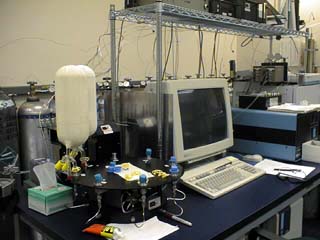11 August, 1998
Tuesday, August 11th, 1998
More About the Carbon Cycle Group:
I have met with Tom Conway today for most part of the afternoon.
He is one of the research chemist of the group and has been here since
1981. He also works with outreach programs to talk about his work to
students of different ages.
Tom is the person who is responsible for all the sampling and
data analysis. The sampling started in the 60's. This group, as others
of CMDL's research groups, has a big job of keeping the bottle-shipping
and receiving arrangements to all stations going in order to maintain
the constant supply of baseline data.
The different gases need to be analyzed with different
instruments. Carbon dioxide, for instance, is being detected using
infrared light. Since it is a greenhouse gas, it will absorb light.
Carbon monoxide, hydrogen, nitrous oxide and sulfohexofluoride are being
analyzed using a gas chromatograph. The isotopes C12 and C13 need to be
measured with a mass-spectrophotometer.
Although the group is monitoring sampling from 60 different
stations around the world and is part of the Global Atmospheric Watch
(GAW) which is supported through the World Bank, it is not possible to
collect data in all areas of all continents. The group would like to
establish sampling stations also in Brazil's rain forest and collect
data there in order to follow the effects of deforestation.
Carbon Dioxide Data Information
If you are interested in following the carbon dioxide analysis
or in general CO2 information, this is the web page of the Carbon
Dioxide Information Analysis Center:
httpc//: cdiac.ESD.ORNL.GOV/home.html
The Carbon Cycle , Fossil Fuel Emissions and What We Can Do!
The fossil fuel emission is rising every year. Green house gases such as
Carbon dioxide and carbon monoxide are accumulating. What can we do?
This is no news but still important to reduce fossil fuel emission
(Daily Camera, 8/10/98):
* Limit driving
* Maintain your vehicle
* Conserve electricity
Here is the Carbon Cycle Group's web page is. You can also find some
educational material:
http://www.cmdl.noaa.gov/ccg/

This is a gas spectrophotometer. The white bottles to the right are the air-sampling bottles. Air samples are taken in these bottles from 60 different sites around the world. The concentration of different gases such as carbon dioxide, carbon monoxide and many others can be measured.
Contact the TEA in the field at
.
If you cannot connect through your browser, copy the
TEA's e-mail address in the "To:" line of
your favorite e-mail package.
|
